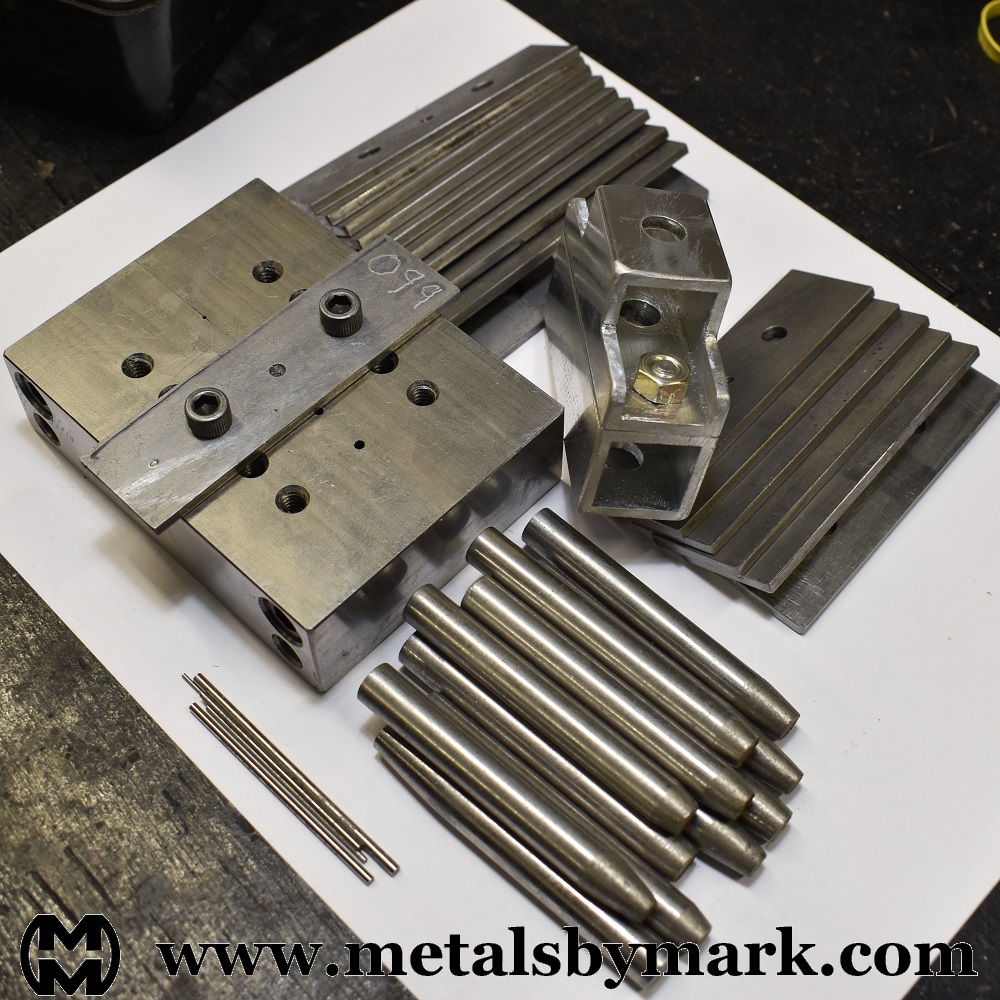
The complete tool
Categories: Jewelry; Projects and equipment
Word count/read time: 415 words; 2 minutes
Rivets are an incredibly strong mechanical connector and a
great aesthetic
for jewelry. Commercial sterling and fine silver rivets are quite limited.
Besides, using them means the piece is no longer legally
handmade.
Handmade matters which is why I make my own rivets. Shaping, filing, and
sanding drain production time. The consistency was meh so it often
involved making extras to get a respectable, matching pair.
It's jewelry so all components have to be worthy.
I looked at rivet-making tools and the solution was obvious: Make a better version
of my prototype. It will make every size rivet I've ever used and extras.
Some people will say it is overkill - overkill was, like, ten steps ago!
Seriously, it should endure for my lifetime so its annualized cost is
quite low.
Finish work on the rivets is significantly reduced. Removable plates ensure
the perfect rivet head diameter. The head profiles
can be domed/rounded, conical, or have other
features; these are flat.
Not including rivet length or fancy add-ons, there are scores of combinations.
Some quick calculations remove any guesswork about how much wire is
required for a given head diameter and
thickness for each of the five wire diameters at any finished length.
While I could have made this with many do-overs
and a tetris of separate pieces, the pro machinists flexed their muscles.
It was slowly transformed traveling to and from the machine shops:
manual machining, wire EDM, then CNCed to final specs.
First it was worth pennies as scrap, then $75, then $250, then even more.
The wire hole diameter was supposed to be tight. The drawplate makes wire a fraction
oversized in some diameters, enough to throw a hissy.
Sanding the wire for a few seconds is easier than re-machining my precision tool.
Also, if
this drawplate becomes unusable and the new one is a tad off the other way
then my modified tool would be sloppy.
Drawplates are a lot cheaper to replace.
Another component is the graphite block that
makes the blanks. It has holes the same size as the rivet tool (wow, what a coincidence).
One more iteration and it should be finalized. Production will improve.
Would producing this tool make sense, outfitting
the competition with tools I slaved so dearly for? The small market,
if any, wouldn't make me rich at the expense of a lot of time.
Besides, few people get excited about making a bazillion different sizes.
Maybe I'll sell handmade rivets instead.
Posted by M: May 20, 2021
Please email any thoughts or comments regarding this post.
Comment Section
NOTE: Your comments will be included in this section
as long as they aren't illegal. This section is censor-free so show me
your intelligence or ignorance and everything in between!
|
2025
Tool Maintenance
Fair Competition
Review: Monster Blue Torch
Check the Price
It's Called the Internet
Wax on, Wax off
Aspect Ratio Calculator
Cache Me if You Can
Try, Try, Try Again
Creative Measuring
And the Exceptions Are?
Tools: Use One or Be One
Scales of Justice
Craft Fair Financials
In a Pickle
Weird Silver Items
Stop, and Think
What's a Mentor for?
Organic
Pass the Torch
Four Fs of Jewelry
Those Are Nice Dimples
Yes, I Have Some
Good Deals
Transportaion Issues
Spining in Circles
Top Purchases 2024
2024
2023
2022
2021
2020
2019
2018
2017
2016
2015
2014
|